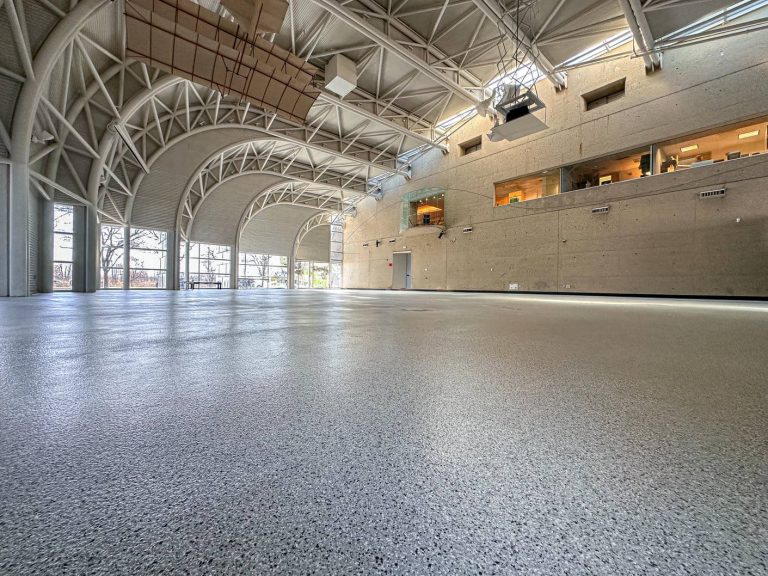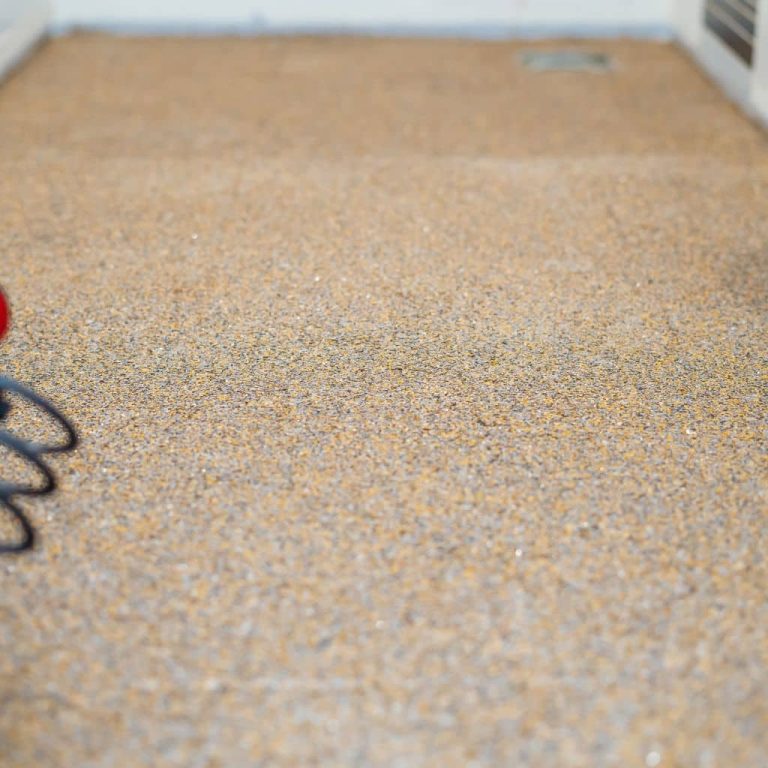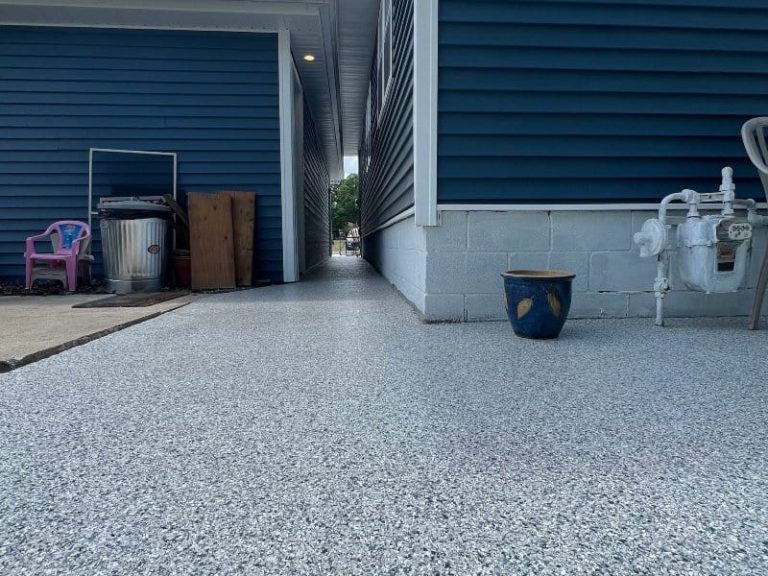Epoxy floor coatings have become a mainstay in both residential and commercial settings, thanks to their durability, chemical resistance, and aesthetic appeal. From garages to basements to industrial warehouses, a well-installed epoxy floor offers a sleek, protective surface that can last for years.
But what happens when things go wrong—when your decorative flakes refuse to stick or the epoxy stays tacky long after it should be cured? In a recent Q&A, concrete-coating expert Crayton Caudill pinpointed two common complaints from DIY epoxy projects:
- “Why are my epoxy flakes not sticking?”
- “Why is my epoxy floor still tacky after 24 hours?”
These issues often trace back to improper surface preparation, product quality, or mixing errors. In this article, we’ll explore the most common reasons behind flake adhesion and curing problems, as well as how to fix or (better yet) avoid them. Whether you’re a first-time DIYer or simply trying to diagnose a subpar application, the tips below can help you achieve the professional-looking finish you want.
Understanding the Basics of Epoxy Floors
What Is Epoxy?
Epoxy coatings are typically made by combining two components: a resin (Part A) and a hardener, or activator (Part B). When mixed in the correct ratio, they undergo a chemical reaction called polymerization, forming a robust, plastic-like material that bonds to properly prepared concrete.
Why Use Flakes?
Decorative flakes—sometimes called vinyl chips—are often broadcast onto the wet epoxy to add texture, slip resistance, and visual flair. Flakes come in endless color combinations, allowing homeowners and businesses to customize the look of their floor while also hiding imperfections. When flakes are embedded correctly, they become a durable part of the floor’s finish.
Common Types of Epoxy Failure
Epoxy floors fail or falter in different ways:
- Poor Adhesion to Concrete: Often due to inadequate surface prep, leading to peeling, chipping, or flaking.
- Bubble Formation or Fish Eyes: Caused by trapped air or contaminants on the floor.
- Tackiness or Softness: Usually from improper mixing ratios or insufficient curing time.
- Flakes Not Sticking: Flakes can come loose or fail to bond if the epoxy cures too fast, the surface isn’t tacky enough, or the base coat is subpar.
Understanding these potential pitfalls is your first step to troubleshooting epoxy coatings.
Why Are My Epoxy Flakes Not Sticking?
In the transcript snippet, Caudill mentions a few possible explanations:
“Because you either didn’t clean your concrete well enough … or you’re using a low-quality product. But more often than not it’s because you’re doing something yourself and you didn’t diamond grind the floor.”
Let’s unpack each of these points.
1. Inadequate Surface Preparation
Concrete floors often come with layers of dust, grease, oil stains, and residual sealers. While cleaning is an essential first step, simply mopping the floor isn’t always enough. Here’s why mechanical preparation matters:
- Contaminants Remain: Even if you wash or etch the concrete, micro-layers of grease or old sealers can linger. These create a barrier that epoxy can’t penetrate.
- Weak Bonding Surface: Epoxy adheres best to a rougher, open-pore surface. If the floor is too smooth or has residual contaminants, the coating (and flakes) may peel or fail to stick.
Diamond Grinding vs. Acid Etching
- Diamond Grinding: Many professionals consider diamond grinding or shot blasting the “gold standard.” Using specialized equipment, they remove the top layer of the concrete, opening its pores for better epoxy adhesion.
- Acid Etching (DIY Alternative): While acid etching can help clean and roughen the concrete, it may not be as effective at removing tough oils or old coatings. It also leaves behind residues, so thorough rinsing is critical.
If you skip or skimp on mechanical prep, your epoxy might never properly bond with the concrete—meaning your flakes could simply flake off.
2. Low-Quality Epoxy or Flake Product
Not all epoxies are created equal. Big-box store kits sometimes contain lower-grade resin formulas that:
- Cure inconsistently
- Have a shorter pot life (meaning less workable time)
- Don’t maintain a tacky enough surface for the flakes to bond well
When the epoxy sets up too quickly—or not at all—broadcasting flakes becomes a challenge. If the product cures too fast, the flakes can’t embed before the epoxy hardens. If it cures too slowly, dust and debris may settle on the surface, interfering with flake adhesion.
3. Improper Timing of Flake Broadcast
Even if you have high-quality epoxy and perfect floor prep, how you broadcast flakes can make or break adhesion:
- Too Early: If the epoxy is still too liquid, the flakes might sink or move.
- Too Late: If the epoxy begins to cure before you’ve thrown on the flakes, they won’t stick effectively to the partially cured surface.
- Uneven Distribution: Throwing flakes unevenly can create bare patches or lumps of flakes that won’t fully bond.
To fix timing issues, start by following the manufacturer’s instructions for when and how to broadcast flakes. Typically, you wait until the epoxy is “tacky”—firm to the touch but still sticky enough to hold flakes in place.
4. Environmental Factors
Temperature and humidity levels can radically affect epoxy’s working time:
- High Temps: Accelerate curing, meaning you have to move quickly when broadcasting flakes.
- Low Temps: Slow curing, sometimes causing the coating to remain sticky for longer than expected, leading to dust settling or potential lumps.
- High Humidity: Can interfere with the epoxy’s cure and lead to surface moisture. If water droplets form on the epoxy, adhesion problems can ensue.
Ensure your workspace meets the recommended temperature and humidity ranges outlined by the product manufacturer.
Why Is My Epoxy Floor Still Tacky After 24 Hours?
Caudill points to mixing errors as the prime suspect:
“Because you more than likely did not mix the product correctly and have too much base or too much activator or it wasn’t mixed long enough.”
Let’s dive deeper into why epoxy sometimes remains sticky long after it should have hardened.
1. Incorrect Mixing Ratios
Epoxy is a precise chemical system. Adding too much resin (Part A) or hardener (Part B) can disrupt polymerization:
- Excess Resin: The coating may remain soft or tacky because there isn’t enough hardener to cure all the resin molecules.
- Excess Hardener: The floor might become brittle or partially cured, or some areas might cure faster, leading to an inconsistent finish.
2. Poor Mixing Technique
Even if your ratios are correct, incomplete mixing can cause pockets of uncured material. Common mistakes include:
- Using a stirring stick instead of a power mixer when the volume is large
- Not scraping the sides or bottom of the mixing container
- Mixing for less time than recommended (many manufacturers suggest at least 2–3 minutes of continuous mixing, depending on batch size)
When the product is unevenly mixed, sections of the floor may cure while others stay soft or tacky. You might also see color streaks if the epoxy includes pigments that aren’t fully blended.
3. Temperature and Ventilation Issues
Like flake adhesion, curing depends heavily on temperature and humidity:
- Cold Environments: Epoxy can remain tacky if it’s too cold for the chemical reaction to proceed at a normal pace. Some products won’t fully cure below 50 or 60°F.
- Poor Air Circulation: Excess humidity or stagnant air can slow curing. On the other hand, extremely strong air flow might cool the epoxy surface and disrupt even curing.
Check the label for recommended temperature ranges, typically around 65–85°F, with moderate humidity. Aim for stable conditions during and after application.
4. Old or Expired Product
Epoxy has a shelf life. If you’re using a kit that’s been sitting on a shelf for a year or more—especially in an unheated garage or under direct sunlight—the chemical components may degrade. An expired or compromised product can lead to partial cures, tackiness, or total failure.
How to Fix Tacky Epoxy
- Test Cure in Small Areas: If only a limited section is tacky, see if you can scrape off the uncured material and re-coat.
- Remove and Re-Apply: If the entire floor is soft or sticky, you might have to grind or scrape away the failing epoxy, thoroughly clean the surface, and start again with fresh product.
- Post-Heat Application: Some products can be coaxed into curing with mild heat (e.g., space heaters), but only if the mixing ratios were correct in the first place.
- Consult the Manufacturer: If you’re unsure, contact the epoxy brand’s technical support for advice. They may provide steps for re-coating or confirm whether the product is salvageable.
Key Lessons for a Successful Epoxy Project
1. Prioritize Surface Prep
Even the best epoxy will struggle if the concrete substrate isn’t properly prepared. Diamond grinding or shot blasting is highly recommended to ensure maximum adhesion for both the epoxy and any decorative flakes.
2. Purchase Quality Materials
Cheap, low-grade epoxy products often have unpredictable cure times and less forgiveness for environmental variances. Reputable brands typically provide clearer instructions, better technical support, and a more consistent result.
3. Follow the Directions Exactly
From mixing ratios to pot life (the time you have before the mixture starts curing in the bucket), epoxy demands precision. If the instructions say to mix for three minutes, set a timer, and stir thoroughly. The same goes for the recommended temperature and humidity ranges.
4. Broadcast Flakes Properly
Familiarize yourself with the epoxy’s re-coat window to know exactly when to toss flakes. If you wait too long, the surface might not be tacky enough to hold them. If you start too soon, the flakes could sink or clump.
5. Plan for Environmental Conditions
Keep an eye on your local forecast. If a cold front is moving in or the humidity is about to spike, consider rescheduling. Controlling the climate in a garage may involve space heaters, fans, or dehumidifiers to maintain ideal conditions.
6. Consider a Professional Installer
While DIY epoxy floors can succeed, professionals have the equipment and know-how to avoid these pitfalls. They’ll diamond grind the floor, accurately mix and apply materials, broadcast flakes at the perfect time, and manage environmental factors. The cost might be higher upfront, but it could save you money and frustration in the long run.
Alternatives to Epoxy
If you’re repeatedly struggling with epoxy or want a longer-term solution, consider:
- Polyurea Polyaspartic Coatings: Known for their flexibility, faster cure times, and superior UV resistance. They also bond well if the concrete is prepared thoroughly.
- Urethane Topcoats: Sometimes applied over epoxy to add UV stability and chemical resistance. However, they still rely on good epoxy prep.
- Polished Concrete: Offers a sleek, industrial look without the risk of peeling or curing mishaps. But it lacks the same chemical and scratch resistance as a resin-based system.
- Interlocking Tiles or Mats: A less permanent solution if you prefer to avoid resin altogether, though they don’t create a fully sealed surface.
Conclusion
Decorative flakes that refuse to adhere and tackiness that persists well past the 24-hour mark are two of the biggest headaches in DIY epoxy floor projects. As Crayton Caudill notes, these problems almost always boil down to subpar surface prep and mixing mistakes. The best way to ensure a flawless finish is to thoroughly grind or shot blast the concrete, choose a reputable epoxy or polymer product, follow the mixing instructions exactly, and broadcast flakes at the perfect stage of tackiness.
Even then, environmental conditions like temperature and humidity can complicate the process, so plan your project around stable weather or use climate control if possible. And if the idea of messing up an expensive kit worries you, don’t hesitate to consult a professional installer who can handle the entire process—from prep to final inspection. Doing it right the first time ultimately saves time, money, and frustration, leaving you with an epoxy floor that looks great and stands the test of wear.


